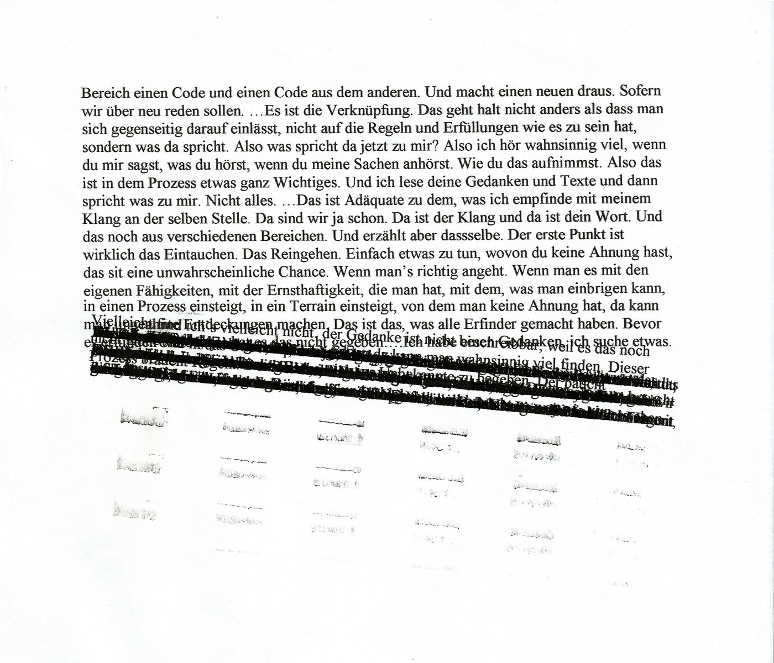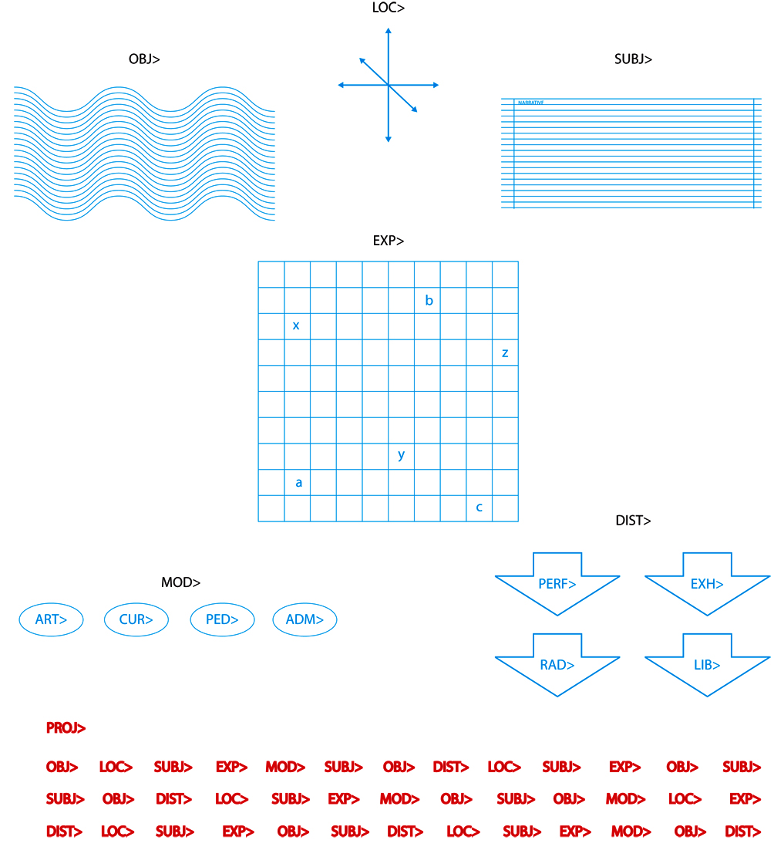The uncertainties, the empty spaces, the interstices and the unnamable are the areas of speaking about science and art which Andrea Sodomka and Doris Ingrisch investigate in the framework of their joint project “Versuche im Und – doing art & science”. Sodomka is a composer, media artist, and member of the artist group alien productions; Doris Ingrisch is a cultural scientist and professor of Gender Studies at the University of Music and Performing Arts Vienna. In their work, both move in interdisciplinary fields, the in-between. A distillation of their conversations over the last two years has flown into the radio play “Versuche im Und”.
It all began on the red sofa in Andrea Sodomka’s studio, where she met with Doris Ingrisch for talks circling the areas of science and art, and their intersections …
DI: That’s exactly to the point which we, I believe, all of us who practise this kind of thinking-beyond or want to delve into that, that it’s attempts to think in the And.
AS: If one were to put it very harshly, one could also say that it is neither-nor.
DI: Yes, it is too. Exactly.
AS: But what is it then?
The law of creativity, thus Wassily Kandinsky, consists of the balance between head and heart, the moment of consciousness and the moment of unconsciousness, of intuition. “As in olden times the sharp ear heard thunder in the quietude of order, thus the keen ear may discern another order in chaos. This order leaves behind its basis ‘either-or’ and slowly reaches a new one – ‘and’.” The 20th century was under the sign ‘and’, he wrote in the year 1927. As the 20th century did not fulfill this task, it appears to remain to the 21st century to do so.
Doris Ingrisch, Pionierinnen und Pioniere der Spätmoderne, Bielefeld 2012, 227
Sound Drifting - I Silenzi Parlano Tra Loro, 1999
Generative on air – on line – on site sound installation
Alien City, Australia, Germany, Great Britain, Yugoslavia, Canada, Austria
15 entry points spread across the world cross-linked to a generative installation.
SOUND DRIFTING was about networking, communication and collaboration, about the individual’s loss of control of his work in favour of shared control (between humans, between machines and humans, between producers and users) in an overall system becoming more and more independent.
Curators: Colin Fallows, Heidi Grundmann
AS: I think that in order to investigate the whole thing we’re attempting to do here, that uncertainties are important for that, too.
DI: Mhm.
AS: Perhaps even more important than what one’s able to describe exactly.
In fact, the term ‘uncertainty’ in the case of quantum mechanics does not make it clear enough that uncertainty does not point out a deficiency, but on the contrary: that it is the result of a much deeper connection between what is spatially present, where ‘everything is connected with everything’ in a much more extensive and intimate manner, which is founded on relatedness rather than interaction. The ‘uncertainty’ is the expression of a holistic, integrated structure of reality. This is immediately comprehensible for us: Every relationship necessarily leads to a loss of isolation, where isolation in turn only enables certainty in the sense of exactness.
Hans Peter Dürr; Auch die Wissenschaft spricht nur in Gleichnissen, Freiburg/Basel/Vienna 2004
XT
alien productions and Machfeld, 2007
The process of crosstalking (XT) is the point of departure for the conjoint 40-minute performance of the artists' collectives alien productions and Machfeld (Sabine Maier and Michael Mastrototaro).
In telecommunication and telephony, crosstalk is often distinguishable as pieces of speech leaking from other people's connections - hence the name, and is caused by a simple physical process: a wire pair represents a resonant circuit, thus it can serve as sender as well as receiver of electrical fields. If an electrical signal, for instance a speech signal, is transmitted via a wire pair which, with multiple other pairs of conductors, is lead within one cable, this signal strays into other wire pairs.
alien productions and Machfeld use this - normally unwanted - effect for their (live) performance which is based exclusively on spoken word. They speak into microphones, and by doing so trigger technical devices like sythesizers, vocoders, stylus printers or granular synthesis programs or dot matrix printers, which in turn start "crosstalking". With the original signal gated out for the audience, as well as the artists themselves, only the sound events of the machines, processed in real time, are audible.
In its structure, XT is based on the four techniques of Xiangsheng, a traditional Chinese form of performance art which originally emerged from imitating the speech and behaviour of another person. The four techniques are: speaking, imitating, bantering, and singing.
The artists speak with eachother, they speak about eachother, and they crosstalk eachother; and, in the end, they will listen to the machines, and what they have to say.
A video documentation of the performance is aviable at http://www.machfeld.net/studio/xt/.
For Kunstradio, alien productions and Machfeld conceived a radiophonic version in 5.1 surround sound of their performance. A stereo mixdown, aviable here, was also selected as the Austrian contribution to the European Art Radio Festival 2007 produced by the Portuguese Radio corporation.
First broadcast on January 28, 2007 on Ö1 Kunstradio.
AS: There I always thought that our common process, this procedure would sharpen my mind,
DI: Yes.
AS: but actually it sharpens my intuition.
In these new forms of thinking, these new forms of knowledge and gender, the beginnings of new dis/orders of knowledge and gender … reason AND intuition are present, however not in a bipolar, separated formation, but in the various shapes of the And, the beyond, the in-between.
Doris Ingrisch, Intuition, Ratio & Gender? in: Andrea Ellmeier / Doris Ingrisch / Claudia Walkensteiner-Preschl (eds.), Ratio und Intuition. Wissen/s/Kulturen in Musik*Theater*Film, Vienna/Cologne/Weimar 2013, 19–43, 39
DIAGRAM#1
Andrea Sodomka, 2013
Based on the Diagram-Sodomka by Adelheid Mers, 2012
First performance:
as part of the project „Sous nos yeux“ curated by Abdellah Karroum at Kunsthalle of Mulhouse (F)
First broadcast: Radioapartment 22, Rabat, Marocco
My method of composition:
On the one hand it was important for me to ’play’ the diagrm as a score. To interpret the notation most presicely. To follow the given lines. On the other hand I aimed for the largest possible absence of intention in my interpretation through sound. That means: not to think much about why I select which sound with which electroacoustic manipulation in which tempo. I followed those intuitions as disciplined as I possibly could.
The sound basis of the composition is recordings of 3 stirng instruments: Cello, Violin, double bass, one sound each. These were modified electro acoustically by ’freezing’ very short excerpts of the instrumental sounds. What resulted are 3 virtual instruments (1 sound each, approximately d1), each of which has the sound characteristis of all three instruments, in different tempers.
These 3 lines - actually 2: subj and obj with a link/sound entanglement in between - flowed together and in the matrix were further divided into their constituent parts and again differently recombined.
Simultaneously with this new mix the sound is separating into smaller and smaller particles. What is left is a polyrhythm that consists of ’grains’ - the smallest particles - of the original sounds. The rhythm is irregular, very queer. To make it audible as a rhythmic experience I added very straightforward machine generated bars in a last step, even though that was not what I had intended. To me, this polyrhythm also means that different parts don’t necessarily mix or flow into each other, but can be selectively used: rhythmically. In any case the sounds are identical from beginning to end, but in different conditions, combination and timings.
Andrea Sodomka, 2013
Translation by Adelheid Mers
Intimate Space
Radio composition for electronics, voice, electric guitar and accordion
Andrea Sodomka, 2009
The poetry of transmission. A story about distance, communication, and intimacy.
“Intimate space is that space around one’s body, about an arm’s length, reserved for those one loves and close friends.”
A composition commissioned by Ars Sonora, Radio Clàsica, RNE – Radio Nacional de España and ORF, Ö1 Kunstradio
First broadcast ORF: September 2009, Ö1 KUNSTRADIO – RADIOKUNST
First broadcast RNE: October 2009, Ars Sonora, Radio Clàsica, RNE – Radio Nacional de España
World premiere as concert and radio installation for mini FM transmitters, 23 September 2009, in the framework of CDMC (Centre for the Diffusion of Contemporary Music) / Festival for Contemporary Music, Alicante, Spain.
Voice: August Black
Accordion: Heidelinde Gratzl
Electric guitar: Helmut Jasbar
Electronics: Andrea Sodomka
with a sound donation by Daniel Lercher
Sound engineer: Anton Reininger

